Although we read with our minds, the seat of artistic delight is between the shoulder blades. That little shiver behind is quite certainly the highest form of emotion that humanity has attained when evolving pure art and pure science. Let us worship the spine and its tingle.
—Nabokov, Lectures on Literature
David Lynch died a little over a month ago. Probably no artist outside of the field of music1 has had a bigger effect on me, and particularly on the way I think about art in general. This is much too small a space to talk about everything his works have meant to me: the bafflement and intrigue of first reading about the director, with zero context, in David Foster Wallace’s essay “David Lynch Keeps His Head”; the even more baffling and intriguing experience of seeing INLAND EMPIRE cold at age eighteen, and the revelation that was my second viewing of it two years later; my first viewing of Mulholland Drive, watched on a bright summer morning on my laptop screen but still frightening me so much I could barely stand to finish it; the emotional and aesthetic intensity of watching Twin Peaks for the first time (with my college girlfriend, who later became my wife); being overwhelmed by Lost Highway on the big screen at Film at Lincoln Center; discovering that The Straight Story was a major work and not a mere curio; watching Part 8 of Twin Peaks: The Return as it aired live and feeling, for one of the few times in my life, the shock of something utterly new.
But I do want to talk about one particular aspect of Lynch’s work that revealed something to me, probably for the first time, that’s still central to my conception of art in any genre (literature, music, visual art). I want to start by looking at an episode directed by Lynch from Twin Peaks’ second season, the epochal Episode 14 (subtitled “Lonely Souls,” if you’re one of those who holds truck with the post facto episode titles). I’ll try not to spoil the episode, which is very susceptible to spoiling, in any detail.
The passage from this episode I’ll be talking about, in brief, concerns Maddie, the cousin of the murdered Laura Palmer. Maddie has been visiting Twin Peaks for a number of weeks, but now informs her aunt Sarah and uncle Leland (Laura’s parents) that she’ll be leaving tomorrow to head home to Missoula, Montana. They assure her that they understand, thank her for visiting, and express their love. (You can watch the scene here for free, starting at 5:29.) The whole brief scene is shot in one long take: an unusual tack for a TV show to take, but one which Twin Peaks had used frequently as something of a visual signature. The scene starts seemingly incongrously, with a very dark close-up on a wildlife painting, as we hear Louis Armstrong’s recording of “What a Wonderful World” begin (it’s not the same as the familiar orchestral recording, but I’m not sure which alternate or live version it is):
Then the camera tracks up and to the side, taking in mantlepiece knickknacks, and then framed pictures of the departed Laura (played by Sheryl Lee):
Then it picks up Maddie (Sheryl Lee again, in the flesh) getting a cup of coffee, and reframes slightly as she walks to sit between her aunt and uncle on the couch, giving us our first stable, if slightly distant and busy, visual composition:
This has all taken just about a minute of screentime: already an unthinkable shot length for most TV shows, but Twin Peaks is a show that is strikingly “classical” in its camera direction, particularly in Lynch’s episodes. Perhaps inspired by the fullscreen frame, resembling the classic Hollywood Academy ratio, Lynch resists cutting into a scene when holding a master shot will do, and frequently uses energetic blocking or the so-called “Spielberg oner” (an unflashy long take with camera movement) to reframe shots instead of cutting to a new one. Plus, this specific technique of beginning a scene by panning around the room and taking in some props before we see any actors is by now a familiar visual strategy of the show, established as early as the first scene of the first post-pilot episode. So far we’re on familiarly quirky ground.
It’s what happens then that raises alarm bells: as the three begin to talk warmly about Maddie’s impending departure, the camera moves with extreme, agonizing slowness. First it pushes in slightly:
It’s hard to tell from stills just how slowly the camera is moving, but the time elapsed between the previous still and this one is about thirty-seven seconds. It’s much slower than the camera movement from the first part of the scene, slower than any camera movement we’re used to, from this work or others. It then begins to track right with the same excruciating slowness. As it does (as you can already see above), it picks up a piece of furniture that partially occludes the frame:
It turns out to be the record player; the recording we’re hearing of Armstrong is diegetic. The camera continues tracking past the player as it temporarily occludes the actors entirely:
And finally settles into an even stranger composition than the original one, with the record player dominating the frame:
The time elapsed between the only two stable compositions in the scene is about a minute and forty-five seconds: again, it’s hard to communicate just how interminable that camera movement seems when you’re watching it. Almost as soon as the camera settles into its final position, the scene ends, its single shot having lasted a little under three minutes.
What does this unusual visual strategy do to the scene? On paper, this scene is basically a bit of exposition: Maddie tells her aunt and uncle her plans and they share a loving moment together. Necessary to set up the episode’s disastrous climax, but hardly in itself a riveting scene. But as shot, it is extraordinarily distressing, almost physically stressful to watch. The thing that especially strikes me about this is that there is no explicit narrative reason why this should be the case. It’s not like in a horror movie (Halloween, say) where the sight of an ominous Something in the background gives a dark, ironic cast to a peaceful foreground, or when a threatening low note in the score gives the lie to an idyllic scene. There is also nothing particularly notable in narrative or “symbolic” terms about the objects the camera picks up as it moves, certainly not about the record player that seems, by its proximity to the camera, freighted with such ominous meaning.2 The camera doesn’t even, really, ironically counterpoint what the three actors on the couch are saying, which does sometimes happen in Lynch. Described in objective terms, it is nothing but a “oner” with some unusual camera movement and off-kilter compositions, but I have never once been able to view the scene, not even the first time when I didn’t know the famous reveal near the end of the episode, without alarm bells going off in my head that SOMETHING IS WRONG. I’d be surprised if anyone ever has. And, of course, something is wrong. But how do we know? What does this scene mean?
There are a couple approaches you could take. One is the “puzzle box” school of Lynch reception, where any narrative opacity or unusual visual schemes in his movies are taken to be disturbances caused by a Gnostically hidden “real meaning,” discovered by correctly interpreting clues the director has strewn in the background: the Mulholland Drive Ending EXPLAINED approach.3 One popular theory holds that evil entities in Twin Peaks feed on electricity; this “explains” the show’s frequent, noncontinuous insert shots of whirring fans and its motif of flickering lights, and by extension could account for the prominently featured record player in our scene above. Thus, the scene has an ominous, distressing feeling because we are focused on an object or force associated with an evil entity in the show’s (hidden) narrative. I think it’s obvious that I find this very unsatisfying, and not only on the rather flimsy narrative grounds. Attempting to account for every disjunction and incongruity in narrative or, in this case, “lore” terms is a good way to tame and smooth away the most striking elements of the narrative or the mise-en-scène.4 Also, viewing the work in this way makes it fundamentally dishonest. It’s no longer speaking directly to us, the audience, but only to the initiate who have correctly interpreted the hermetic “clues” (or watched an explainer video about them). It’s difficult or impossible for something that works like that to be emotionally direct, and emotional directness is an essential part of the makeup of Twin Peaks in general and this scene in particular. It’s very clever, in the pejorative sense.
We are on somewhat more promising ground with formal analysis. We could say that an unmotivated camera movement like the one in the scene above is calculated to introduce an unsettled mood—we perceive some sort of other, maybe sinister, force working under the surface of the scene that “causes” the camera to move as if of its own accord. (This is a signature trick of the great Italian horror director Dario Argento, the master of creating ominous moods through deranged camera direction.) The extreme slowness of the movements, too, feels unnatural, and the lack of cutting gives us no relief from it. And having an object occlude the frame to the degree that the record player does, even though there’s no obvious reason for it to be there, is itself anxiety-inducing. It blocks our view of what we’re trying to look at, draws our attention, and (in the final moments of the scene) looms over the actors, and seems to enclose or entrap them.
I think all of that is true and does go a ways towards accounting for the effect the scene has. But all of those reasons don’t seem to sum to the actual product. There’s a sort of mysterious remainder, a gulf between saying “It’s unsettling when the camera moves very slowly and when objects block the frame” and the effect of actually viewing it. The truth is that the question “What does the scene mean?” isn’t the right one. It doesn’t mean anything, not in a way that accounts for anything important about it. The impact of the scene isn’t reducible to either its narrative or formal elements; it points to nothing outside of itself, and has an affective force all out of proportion to any interpretation of it. The importance of the scene is inextricable from the details of the construction of it and can’t be duplicated in any other medium. It is pure mood, pure emotional affect, only tenuously connected to what’s “going on” in the narrative; it’s pre-rational. To use an old and not terribly useful distinction, it’s all about form and very little about content.
It wasn’t just this scene that was a revelation for me, of course; it was Lynch’s aesthetic in general, which almost always foregrounds this sort of intuitive, affective technique over narrative or symbolic connections. Just from Twin Peaks, one could also mention the terrifying moment in Episode 8 where the camera suddenly begins to track down the halls of the hospital with no apparent motivation, or (from the same episode) the floating Steadicam in the scene when Leland sings “Get Happy,” introducing a level of subliminal creepiness to an already unsettling scene.5 It’s not only a frightening or ominous mood that can be generated with this sort of intuitive, imagistic technique, of course; one could look at the very opening shot from the same Episode 14 that has the record player scene, which immediately sets up an offbeat, humorous atmosphere with a very distinctive, Tatiesque composition:
When I was first watching the show, blind, and saw this opening shot, I could immediately tell that Lynch and not one of the series’ other directors had directed this episode. One of the things Lynch did for me, with his particularly distinctive and aggressive style, was to permanently cure me of any lingering notions that TV and film are sort of illustrated audiobooks, showing us in a basically neutral way what happens in the script. Lynch, because he is a genius stylist but also a very aggressive stylist, forces even an inexperienced viewer to realize that the way events are filmed is everything: camera placement, composition, blocking, color, lighting, sound, music, can tell us as much or more about the import of a scene or the relationships between characters and events as the dialogue or plot. Imagine that in the record player scene above, when Maddie moves to the couch, the camera follows her and frames the actors in a cozy three-shot, or follows a shot–reverse shot pattern. That would be a completely appropriate technique for a certain kind of scene, but it would not remotely be the same scene, affectively or narratively, even if every word of the script was the same. The reasons why these moments work as they do are mysterious, but the effect is direct and undeniable.6 As David Foster Wallace wrote in the aforementioned essay: “[Blue Velvet’s] obvious "themes"… were for us less revelatory than the way the movie's surrealism and dream-logic felt: they felt true, real.”
It is, of course, natural to respond to Lynch this way; he is associated with cinematic surrealism (even though Eraserhead and INLAND EMPIRE are his only sustained surrealist films) and he also trained as an abstract-expressionist painter, both of which are styles that privilege the unconscious and inexplicable over the rational. But having been guided to it by Lynch, I began to see all art this way, not just that in anti-rational modes like surrealism or expressionism. It’s just as true of Steven Spielberg or Buster Keaton, or Charles Dickens or Shakespeare, or Aeschylus or Homer. The lasting value of their art (for me anyway) has nothing to do with themes, with symbolism, or even per se with whatever events are depicted. It’s about those mysterious and euphoric moments where a specific and unique mood is created through techniques that can be analyzed but not ultimately reduced away or rationally accounted for. All worthwhile art, in no matter how “realist” a mode, ultimately creates and then operates within its own dream-world, the same way Lynch does. Plots, characters, themes, social concerns, etc. can be more or less important in a given work, but in the end they all combine alchemically to contribute to the only important thing: whether the work feels true, as Wallace says. Other than in music (which is sort of a special case since it has this quality almost by default), I’ve never had this brought home to me more forcefully than in David Lynch’s films. It’s for that epiphany as well as for the works themselves that I’m most grateful to him.
Though of course Lynch was not strictly “outside of the field of music,” having collaborated on a number of albums—including writing the lyrics for Julee Cruise’s 1989 proto–dream pop classic Floating into the Night, several of whose songs were used unforgettably in Twin Peaks.
I had a whole thing typed up about this habit of interpreting Lynch’s films like they’re all remakes of Christopher Nolan’s Memento, which is one of my pet annoyances, but I cut it because it was a distraction from what I was originally trying to talk about. I might write something else specifically concerning this later, but suffice to say I could tell you stories from the 2017 Twin Peaks: The Return Facebook groups that would make your hair curl.
It is true that this record player returns later in the episode, in an extremely ominous way (with the record spinning silently in its outer groove). So this scene gives it a greater charge when we see it again later, but that doesn’t really account for the impression it makes in its first appearance. Plus it’s more of an intuitive dream-image than something that can be explained in narrative terms.
Lynch later used the Steadicam to very similar purposes in the infamous diner scene from Mulholland Drive.
Lynch, in his autobiography Room to Dream and elsewhere, talks repeatedly about the work required to find the right mood, a work that is intuitive or even unconscious but no less diligent for that: “There’s a feeling, and it has to be a certain way” is a typical formulation of his, in its eloquent vagueness.




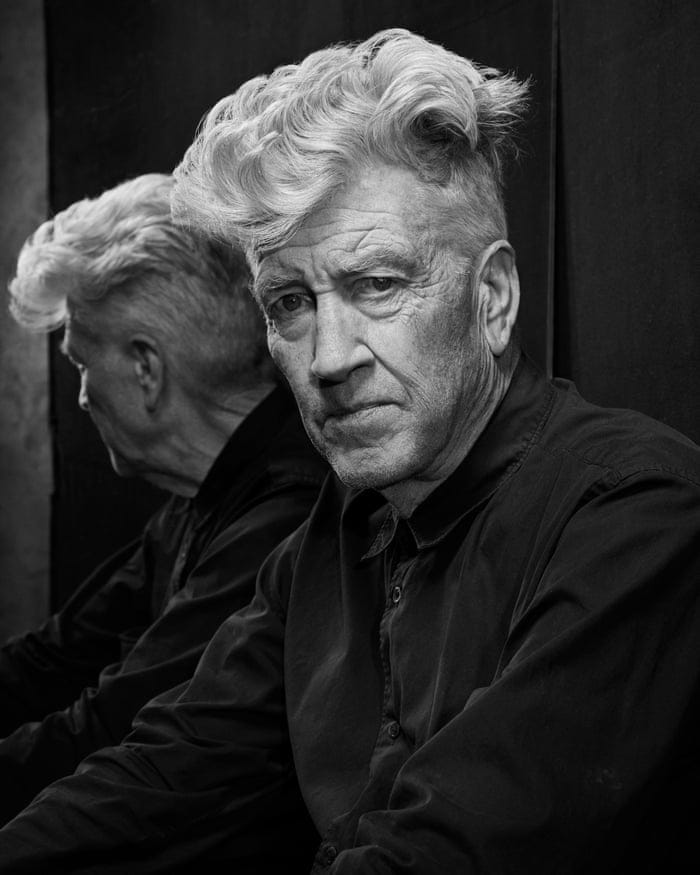

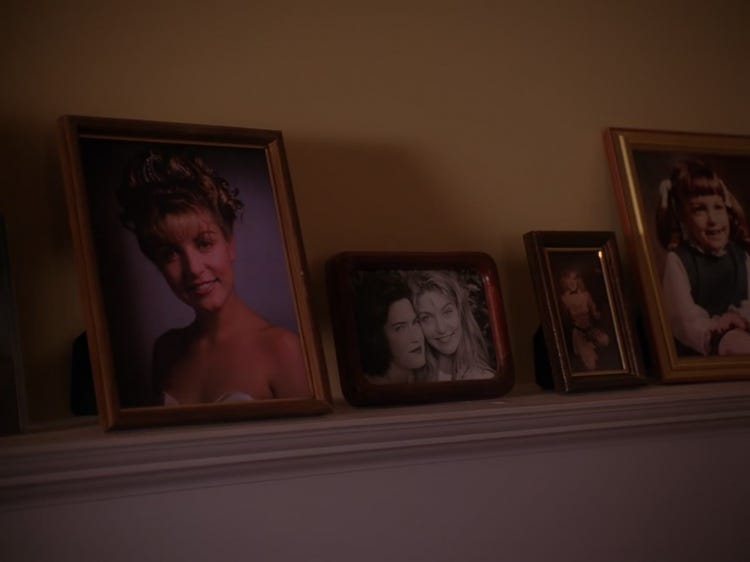
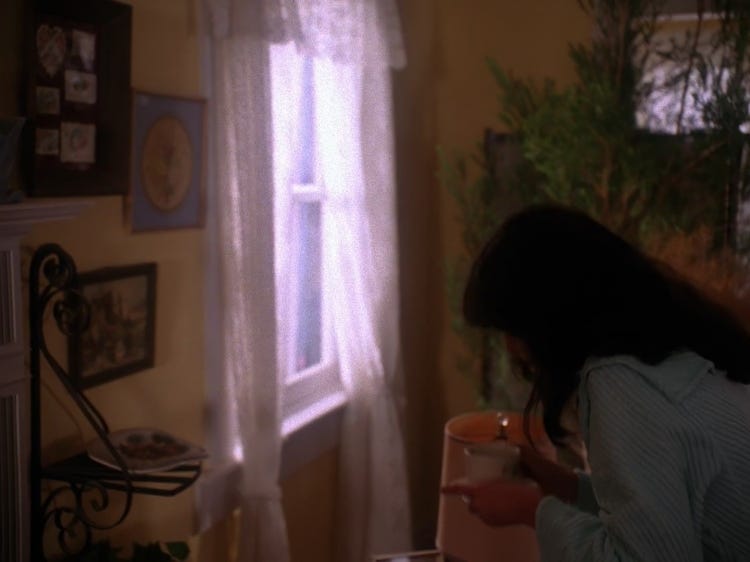
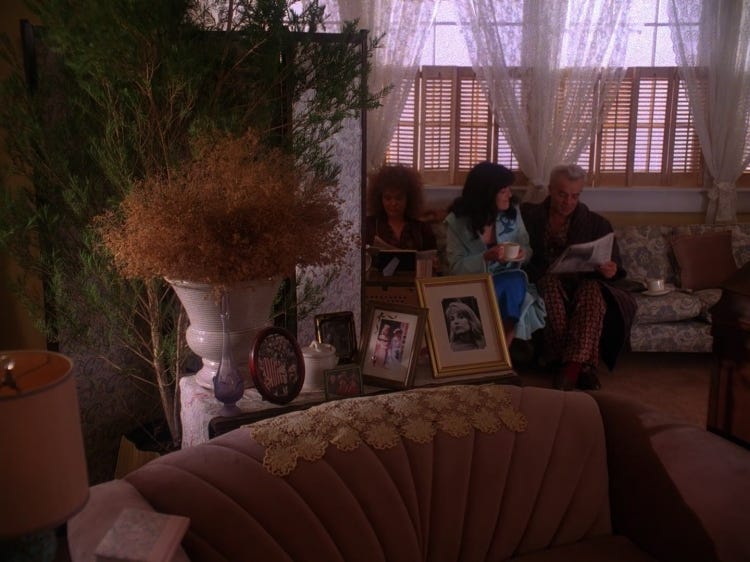
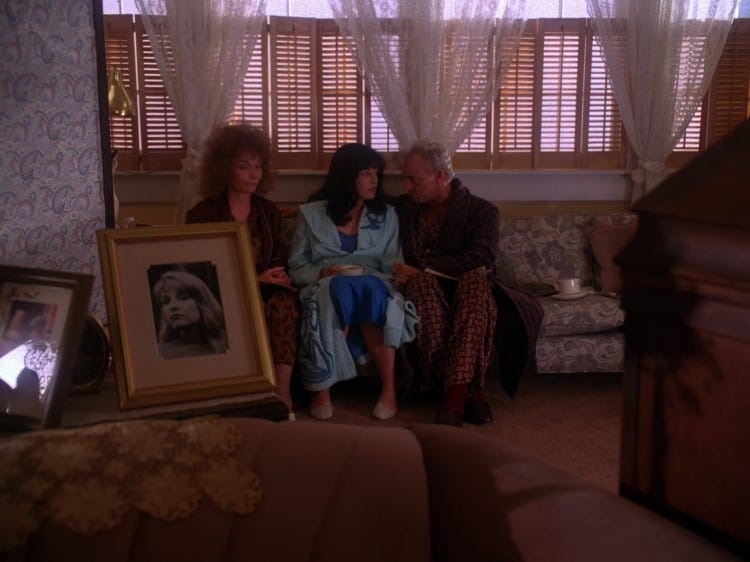
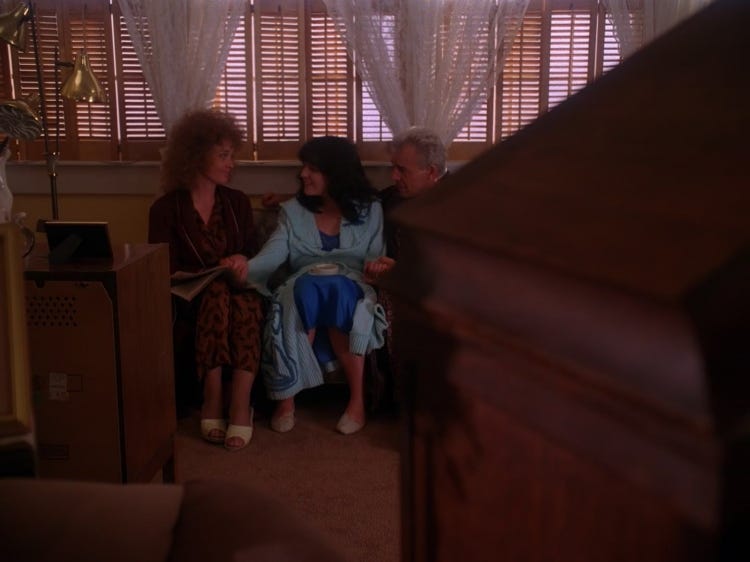

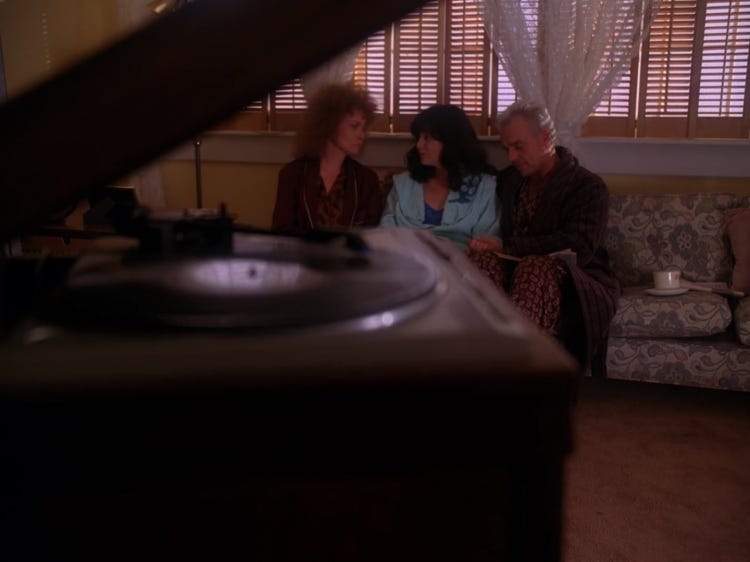


Fantastic analysis and reflections.